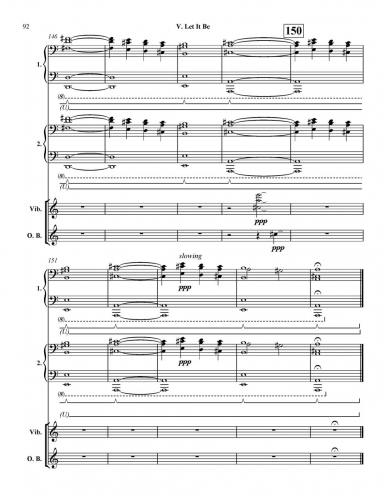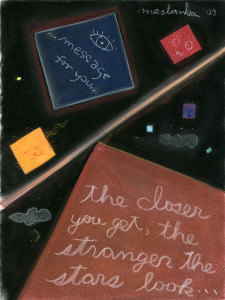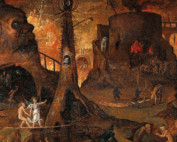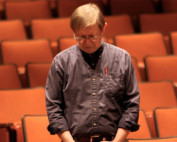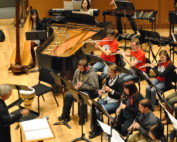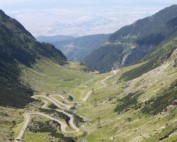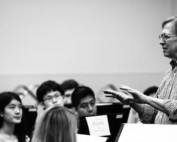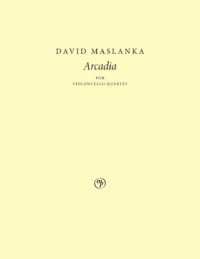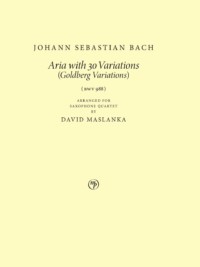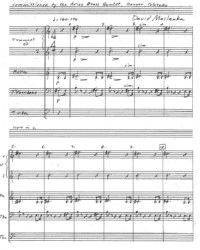Project Description
Two Pianos and Two Percussionists
2009
50 min.
Listen Now
CanAm Piano Duo; Karen Beres & Christopher Hahn, piano; Lance Drege & David Steffens, percussion
On the album This is the World (2012)
Instrumentation
Pno-2 | Perc-2
- Crotales
- Orchestra Bells
- Vibraphone
- Marimba
- Suspended Cymbal
- Chimes
- Metal Wind Chimes
- Tam-tam
- Snare Drum
- Bass Drum
Movements
- Nighthawks (after the painting by Edward Hopper)
- Do You Know My Name?
- Out of the Blue
- The Closer You Get, the Stranger the Stars Look…
- Let It Be
Commissioned by
the Thomas S. Kenan Institute for the Arts at the University of North Carolina School of the Arts
Premiere
January 2010 by the CanAm Piano Duo (Karen Beres and Christopher Hahn), and percussionists Lance Drege and David Steffens
Description
This is the World is a set of largely interior tone poems for a two-piano, two-percussion ensemble. The music is spacious and patient, with simple rhythms, slow harmonies, expansive and touching melodies, and moments of ferocity, whimsy, and grandeur. Although old-time Chorale melodies play an important role in this music, the Nighthawks painting of Edward Hopper is foundational to the whole piece. This painting from 1942 touches something enduring about the American heart and experience, specifically an element of darkness, estrangement, and waiting which I wish to see brought forward and transformed in our time. We are at the cusp of enormous change.
Listing the work in programs
The full title is styled as follows: This is the world we know, the world of air and breathing and sun and beating hearts. “This is the World” is the appropriate short form.
Program Note
The overall feeling of This is the World is one of quiet awe at the nature of our world, both the planet on which we live, and the amazing web of life that it supports – not only that but its place, and our place in the universal web of life, the jeweled “net of Indra.”
The Nighthawks painting of Edward Hopper is his iconic contribution to American culture. It is one of my favorite paintings. It captures something absolutely fundamental about the American experience, and that is expressed probably more by the architecture of the picture – the amazing collection of shapes, and the relationship of light to dark, especially the overwhelming darkness – than by the unspoken “story” of the diner and the people in it. My music expresses some aspects of my own take on the “story,” especially the hidden life in the blank windows of the building in the background, but my overall composition is, as well, a parallel to Hopper’s lifelong preoccupation with shapes and light. He managed to convey powerful unspoken human and universal elements though abstract forms.

Edward Hopper, Nighthawks, 1942, Art Institute of Chicago
The very sweet melody and luminous harmonies of “Do You Know My Name?” touch me in a very hard way every time I play through this music. The melody is derived very loosely from the Bach chorale On the Fortieth Day After Easter (Als vierzig Tag’ nach Ostern war’n, BWV 266). The title “Do You Know My Name” comes with no further explanation….
“Out of the Blue” grows out of the Chorale melody Christ is Risen (Christ ist erstanden, BWV 276). This melody has an inexpressible mystery in it for me, and I have used variations of it in several other compositions. “Out of the Blue” suggests the sudden arrival of something surprising – in this case a luminous joy.
“The Closer You Get, the Stranger the Stars Look…” began as a whimsical pastel drawing that I made some years ago. The stars are square(!), one is a Cheshire cat, one has a “message for you,” one has horns and fangs. This quiet and whimsical music suggests a deep listening to one’s innermost self.
“Let It Be” embodies yet another chorale melody: Lord, Do Not Be Angry With Me (Herr, straf mich nicht in deinem Zorn, BWV 338). The music is a deep prayer for peace within, peace with others, peace with our beautiful world, and the emergence of our lives as children of the universe.
Further Reading
Interview with Tiffany Woods (2003)
In May 2003, Tiffany Woods emailed David a series of questions in the course of writing a paper. She was a student at the University of North Carolina Greensboro and taking a Band Literature course [...]
From the Maslanka Archive – No. 34, Julian Velasco’s Interview of Gary Green
From the Maslanka Archive features media and stories of David's life and work. This week, we are excited to feature Julian Velasco's interview of Gary Green from the Wharton Center in East Lansing, MI from October 24, 2017.
From the Maslanka Archive – No. 33, John Floridis’s Interview of David
From the Maslanka Archive features media and stories of David's life and work. This week, we are excited to feature an episode from Montana Public Radio's Musician's Spotlight featuring John Floridis interviewing David about his music and background as a composer.
From the Maslanka Archive – No. 32, Julian Velasco’s Interview of David – Part 2
From the Maslanka Archive features media and stories of David's life and work. This week, we are excited to feature Part 2 of Julian Velasco's interview of David from his home in Missoula, MT in 2016.
From the Maslanka Archive – No. 31, Julian Velasco’s Interview of David – Part 1
From the Maslanka Archive features media and stories of David's life and work. This week, we are excited to feature Part 1 of Julian Velasco's interview of David from his home in Missoula, MT in 2016.
Maslanka Weekly: Best of the Web – No. 110, Images of Hell
Maslanka Weekly highlights excellent performances of David Maslanka’s music from around the web. This week, we feature three of David's works that reference Hell: Hell's Gate, A Child's Garden of Dreams, and O Earth, O Stars.
From the Maslanka Archive – No. 29, David on Dreaming and the Unconscious Mind
From the Maslanka Archive features media and stories of David's life and work. This week, we are excited to feature a speech David gave on matters of dreaming and the unconscious mind before a performance of A Child's Garden of Dreams by the James Madison University Wind Symphony.
From the Maslanka Archive – No. 15, A Child’s Garden of Dreams
From the Maslanka Archive features media and stories of David's life and work. This week, we are excited to feature pictures from David's residency with Stephen K. Steele and the Illinois State University Wind Symphony for a performance of A Child's Garden of Dreams in 2012.
Maslanka Weekly: Best of the Web – No. 72, Life
Maslanka Weekly highlights excellent performances of David Maslanka’s music from around the web. This week, we feature three of David’s compositions that focus on the spirit of life and living: Unending Stream of Life, Traveler, and “Movement 4” from A Child's Garden of Dreams.
Maslanka Weekly: Best of the Web – No. 69, Dream Space
Maslanka Weekly highlights excellent performances of David Maslanka’s music from around the web. This week, we feature three of David’s compositions (of which there are literally dozens to choose from) that explore a vast array of dream space: A Child's Garden of Dreams, Traveler, and California.
Maslanka Weekly: Best of the Web – No. 66, Vistas
Maslanka Weekly highlights excellent performances of David Maslanka’s music from around the web. This week, we feature three of David’s compositions that emulate various kinds of vistas: Symphony No. 8, A Child's Garden of Dreams, and Symphony No. 6.
Maslanka Weekly: Best of the Web – No. 63, Malcolm W. Rowell, Jr.
Maslanka Weekly highlights excellent performances of David Maslanka’s music from around the web. This week, we feature three of David’s compositions that Malcolm W. Rowell, Jr. and the University of Massachusetts-Amherst Wind Ensemble championed: A Child's Garden of Dreams, Symphony No. 4, and Tears.
Maslanka Weekly: Best of the Web – No. 48, Water Music
Maslanka Weekly highlights excellent performances of David Maslanka’s music from around the web. This week, we continue to look at more of David's music that uses water as a symbol or motif: A Child's Garden of Dreams, Sea Dreams: Concerto for Two Horns and Wind Ensemble, and UFO Dreams: Concerto for Euphonium and Wind Ensemble, Movement II - "The Water is Wide."
Maslanka Weekly: Best of the Web – No. 39, Dreams & Meditations
Maslanka Weekly highlights excellent performances of David Maslanka’s music from around the web. This week, we feature three compositions that specifically mention "dreaming" or "meditation" in their title: A Child's Garden of Dreams, Movement I, Sea Dreams: Concerto for Two Horns and Wind Ensemble, Movement III, and Recitation Book, Movement I, "Broken Heart: Meditation on the chorale melody Der du bist drei in einigkeit."
David Maslanka: Works for Younger Wind Ensembles
Here are more than twenty works for wind ensemble, arranged in approximate ascending order of difficulty, with commentary by David Maslanka
The Nature of Consciousness: Correspondence
We'd love to encourage you to write to David with questions or comments that you have about his music. He loves hearing your thoughts and feelings. Get in touch on the Contact page. June 6, [...]
Recording the Wind Ensemble Music of David Maslanka
Mark Morette of Mark Custom Recording shares his extensive experience in recording wind ensembles.
Remarks before the premiere of A Child’s Garden of Dreams, Book 2
Remarks made 7 December 2008 in Boone, NC before the premiere of A Child's Garden of Dreams, Book 2, by the Appalachian Symphony Orchestra, James Allen Anderson, conductor. I'm not going to say [...]
Some things that are true: Reflections on being an artist at the end of the 20th century
Society of Composers Incorporated Region VIII Conference, University of Montana at Missoula. Keynote address by David Maslanka – November 20, 1998 As soon as one speaks about “truth” there will be objections. Since we live [...]
An Analytical Study of David Maslanka’s A Child’s Garden of Dreams
The five movements of A Child's Garden of Dreams are inspired by five dreams selected from Carl Jung's Man and His Symbols. Dr. David Booth's doctoral dissertation on A Child's Garden of Dreams provides an analysis of each of the work's five [...]
